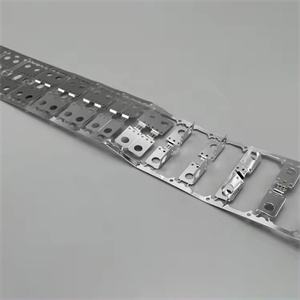Metal Stamping Dies Hardware Parts Progressive Die Stamping For Hinge
Progressive die stamping has significant application advantages in the field of stamping processing, but there are also some disadvantages that cannot be ignored.
Advantages :
1. High efficiency: The progressive die stamping can complete multiple processes in one stroke, such as punching, bending, forming and drawing, etc., so its productivity is higher than that of other die types, which helps to achieve large-scale, high-speed continuous production.
2. Operational safety: Due to the high degree of automation, the operator does not have to put his hand into the dangerous area during the stamping process, thus reducing the risk of work-related injuries.
3. High precision: The progressive die stamping is produced using advanced CNC technology and material manufacturing process, which can ensure the high precision and high quality of the workpiece.
4. Flexibility: The design of the progressive die stamping mold is flexible, and the number of stations and the sequence of processes can be adjusted according to the needs to adapt to different production needs.
Disadvantages:
1. High cost: The structure of the progressive die stamping mold is complex and the manufacturing accuracy is high, so the manufacturing cost is relatively high. In addition, production and maintenance costs are also increased due to the need for high-precision equipment and skilled operators.
2. Long cycle: From design to manufacturing, the cycle of progressive die stamping mold is long, which requires sufficient preliminary preparation and later commissioning, which may affect the production schedule.
3. High technical difficulty: the design and manufacturing technology of progressive die stamping mold is high, and professional technicians are required to operate and maintain. In the event of a failure or the need for adjustment, it can take a long time and be costly to technology.
Workpiece accuracy limitations: Since each process is completed at different stations, the positioning accumulation error may affect the accuracy of the workpiece, especially when manufacturing large and complex workpieces
